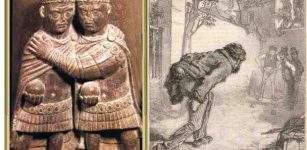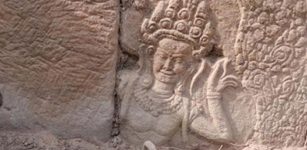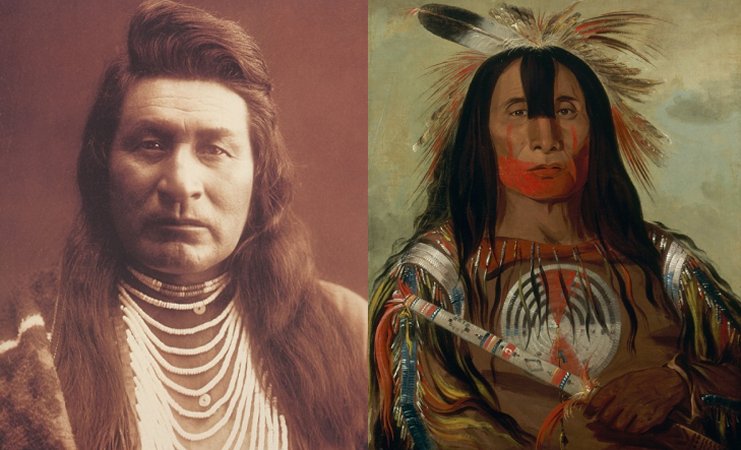Why Do Native Americans Often Wear Long Hair?
Conny Waters - AncientPages.com - Native Americans are famous for their long hair and there is a reason why they let it grow. To Native Americans, hair is of special spiritual significance.
Though the meaning of the hair varies among the tribes, it is nevertheless very important not to cut it. Hairstyles among the tribes can be different and hair can be loose, braided, or worn in a knot. Wearing long hair is much more than a tradition. Native Americans deeply believe hair is a source of strength and power. Hair is considered to be an extension of the soul and a way of having a union with the infinite. By cutting your hair, you lose a small part of your relationship with yourself.
Credit: Public Domain
Many cultures, not only native Americans see hair as something very precious. “hair has so often been thought of as containing the essence of individuality and personhood; a lock of hair can serve as a synecdoche for the body whence it came, possessing in the eye, or rather fingers, of the beholder stronger representational power than, for example, a painted portrait. It is for this reason not surprising that the growing, grooming, cutting, shaving or losing of hair – on the body and head – were often associated with transformative life experiences, with rites and rituals, and with the marking of cultural difference.” 1
Tribes have different teachings about the value of hair, but children are taught they shouldn’t cut their hair unless they have experienced a significant loss. This could be the death of a loved one, a traumatic event or something else that changed one’s life dramatically.
When someone passed away, there is a custom to take a lock of the beloved dead, covering in pretty clothing, something it was supposed that he or she would like to wear if living.
See also:
Native American Sun Dance: Important Ceremony Of The Plains Indians Of North America
Cedar – Sacred Tree With Medicine Power In Native American Beliefs
Native American Tradition Of A Vision Quest – How To Enter The Spiritual World
“This “spirit bundle,” as it was called, was suspended from a tripod, and occupied a place of honor in the lodge. At every meal time, a dish of food was placed under it, and some person of the same sex and age as the one who once was must afterward be invited in to partake of the food. At the end of a year from the time of death, the relatives made a public feast and gave away the clothing and other gifts, while the lock of hair was interred with appropriate ceremonies.” 2
In modern times it happens far too often that Native Americans are bullied and discriminated for wearing long hair. According to L.G. Moses, a professor at Oklahoma State University government officials in the 1800s tried to force native Americans to be more like settlers. This was done by forcing youngsters and adults to cut their hair. The argument was that long hair was symbolizing a wild, uncivilized person.
This practice is still alive and there are many modern schools, prisons and some workplaces where Native Americans are not allowed to keep their long hair. They must simply cut it. Native Americans consider this discrimination, and some had the courage to resist the pressure to cut the hair. In many cases, natives were forced to take legal action to fight for their rights.
Written by Conny Waters – AncientPages.com Staff Writer
Copyright © AncientPages.com All rights reserved. This material may not be published, broadcast, rewritten or redistributed in whole or part without the express written permission of AncientPages.com
Expand for references- Rosenthal, Angela. "Raising Hair." Eighteenth-Century Studies38, no. 1 (2004): 1-16.
- Kent Nerburn - The Wisdom of the Native Americans
More From Ancient Pages
-
 On This Day In History: Mary Queen Of Scots Born – On December 8, 1542
News | Dec 8, 2016
On This Day In History: Mary Queen Of Scots Born – On December 8, 1542
News | Dec 8, 2016 -
 A Remarkably Well-Preserved Wooden Well Dating Back To The Bronze Age Uncovered In Benson, Oxfordshire
Archaeology | May 10, 2024
A Remarkably Well-Preserved Wooden Well Dating Back To The Bronze Age Uncovered In Benson, Oxfordshire
Archaeology | May 10, 2024 -
 Legend Of Marguerite de Bressieux: Brave Noblewoman Who Sought Revenge For Sexual Assault
Featured Stories | Mar 29, 2020
Legend Of Marguerite de Bressieux: Brave Noblewoman Who Sought Revenge For Sexual Assault
Featured Stories | Mar 29, 2020 -
 Spectacular 2,500 Years Old Shwedagon Pagoda In Myanmar – World’s Oldest Pagoda
Featured Stories | Oct 18, 2018
Spectacular 2,500 Years Old Shwedagon Pagoda In Myanmar – World’s Oldest Pagoda
Featured Stories | Oct 18, 2018 -
 Mysterious Sanctioned Ancient Temple In Jerusalem Create Some Biblical ‘Problems’
Archaeology | Mar 5, 2020
Mysterious Sanctioned Ancient Temple In Jerusalem Create Some Biblical ‘Problems’
Archaeology | Mar 5, 2020 -
 Medieval Ring Found In Piast Stronghold Near Gniezno, Poland – Is A Unique Christian Artifact
Archaeology | Nov 28, 2019
Medieval Ring Found In Piast Stronghold Near Gniezno, Poland – Is A Unique Christian Artifact
Archaeology | Nov 28, 2019 -
 Manannán Mac Lir – Irish God Of Sea, Healing, Weather And Master Of Shapeshifting
Celtic Mythology | Mar 2, 2023
Manannán Mac Lir – Irish God Of Sea, Healing, Weather And Master Of Shapeshifting
Celtic Mythology | Mar 2, 2023 -
 Ancient Egyptians Played Bowling 5,000 Years Ago
Ancient History Facts | Feb 22, 2016
Ancient Egyptians Played Bowling 5,000 Years Ago
Ancient History Facts | Feb 22, 2016 -
 The Anglo-Saxon Migration: New Insights From Genetics
Archaeology | Sep 21, 2022
The Anglo-Saxon Migration: New Insights From Genetics
Archaeology | Sep 21, 2022 -
 Long-Lost Viking Waterway Leading To Orkney, The Great Norse Empire – Discovered
Archaeology | Aug 5, 2020
Long-Lost Viking Waterway Leading To Orkney, The Great Norse Empire – Discovered
Archaeology | Aug 5, 2020 -
 2,800-Year-Old Urartu Jars Uncovered In Eastern Turkey
Civilizations | Sep 9, 2015
2,800-Year-Old Urartu Jars Uncovered In Eastern Turkey
Civilizations | Sep 9, 2015 -
 Neanderthals Invented Or Developed Birch Tar Making Technique Independently From Homo sapiens
Archaeology | May 30, 2023
Neanderthals Invented Or Developed Birch Tar Making Technique Independently From Homo sapiens
Archaeology | May 30, 2023 -
 Roman Herculaneum: Men And Women Had Different Diets – New Study
Archaeology | Aug 26, 2021
Roman Herculaneum: Men And Women Had Different Diets – New Study
Archaeology | Aug 26, 2021 -
 3,000-Year-Old Shoe Found On A Beach In Kent, UK
Archaeology | Feb 24, 2023
3,000-Year-Old Shoe Found On A Beach In Kent, UK
Archaeology | Feb 24, 2023 -
 Apsara Carvings Dated To 12th Century Uncovered At Takav Gate In Angkor, Cambodia
Archaeology | May 5, 2022
Apsara Carvings Dated To 12th Century Uncovered At Takav Gate In Angkor, Cambodia
Archaeology | May 5, 2022 -
 Discovery: Massive Gawro Wall Dated To The Antique Age: Was It A Symbolic Or Defensive Structure?
Archaeology | Nov 9, 2019
Discovery: Massive Gawro Wall Dated To The Antique Age: Was It A Symbolic Or Defensive Structure?
Archaeology | Nov 9, 2019 -
 Why Were The 4,000-Year-Old Native American Shell Ring Villages Suddenly Abandoned?
Archaeology | Mar 3, 2022
Why Were The 4,000-Year-Old Native American Shell Ring Villages Suddenly Abandoned?
Archaeology | Mar 3, 2022 -
 Burnt Food Remains In Neolithic Cooking Pot Sheds Light On 5,000-Year-Old Food Preparation
Archaeology | Jan 23, 2024
Burnt Food Remains In Neolithic Cooking Pot Sheds Light On 5,000-Year-Old Food Preparation
Archaeology | Jan 23, 2024 -
 On This Day In History: Ceres Discovered By Giuseppe Piazzi – On Jan 1, 1801
News | Jan 1, 2017
On This Day In History: Ceres Discovered By Giuseppe Piazzi – On Jan 1, 1801
News | Jan 1, 2017 -
 Secrets Of The Lost Tomb X – Enigmatic Boxes And Unusual Samples – Part 2
Ancient Mysteries | Apr 12, 2019
Secrets Of The Lost Tomb X – Enigmatic Boxes And Unusual Samples – Part 2
Ancient Mysteries | Apr 12, 2019

